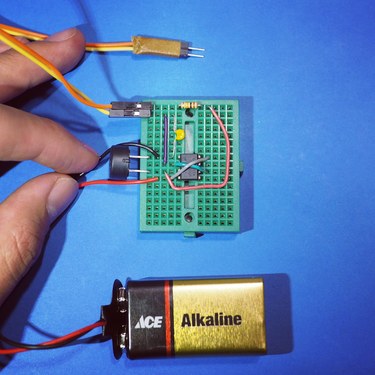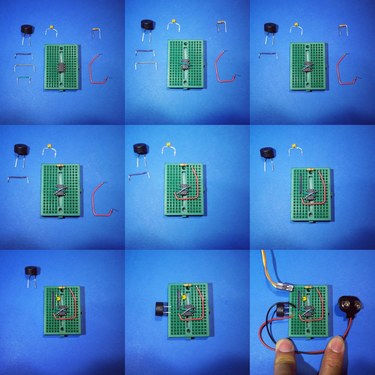## What Does It Do? **The Coqui: a simple device to read a sensor via an audible tone.** We're exploring using audio frequencies to convey sensor readings -- like a modem, but even simpler -- in order to make sensor readings more accessible for people (or to enable data transmission over ubiquitous audio jacks on PCs and smartphones). ## Latest version The [latest and simplest version of the Coqui](/notes/warren/03-01-2019/build-a-sound-generating-coqui-conductivity-sensor) can be seen in the following images. This version differs from [the previous](/notes/ashkaya/09-17-2016/build-a-coqui-a-simple-water-conductivity-sensor) in a few ways: * smaller, cheaper circuitboard (breadboard) * fewer wires * flatter wires which make it easier to see the circuit However, the circuit is fundamentally the same! Click these images to enlarge: [](/i/28988?size=original) [](/i/32338?s=o) ## Assemble the Coqui Here are a few guides to building different versions of the Coqui: [notes:grid:activity:coqui] ## Coqui versions The Coqui has been refined, remixed, and modified plenty over the years. [activities:coqui-version] ## Modify the Coqui [activities:coqui-mods] ## Do something with the Coqui Once you've built a Coqui, here are a few things you can do with it: [notes:grid:activity:coqui-usage] Add an activity or request an activity guide you don't see listed **** ## Frequently Asked Questions [questions:coqui] **** [](https://i.publiclab.org/system/images/photos/000/007/410/original/coquibb.JPG) A Coqui is a simple, inexpensive, open source device that generates an audible tone that is based on any electric resistance-based measurement. For example, a Coqui can measure: * conductivity of liquids * temperature * ambient light ## Build a Coqui Instructions on the breadboard-based "BBv1.0" edition of the Coqui can be found here: http://publiclab.org/notes/donblair/09-30-2014/coqui-bbv1-0 ### Notes - The github repo for a more permanent printed circuit board version of the coqui is [here](https://github.com/OpenWaterProject/coqui) The Coquí is a circuit that allows you to 'hear' the readings from various sensors. Once the Coquí is assembled, you'll be able to 'hear' the conductivity of a solution, the temperature of a room, or the color of a pH test strip. The design was named (onomatopeically) after the several species of small frogs which have a loud, distinctive call at night. ### Demo Coqui applications - [Testing the conductivity of a solution](http://publiclab.org/notes/donblair/09-30-2014/coqui-bbv1-0-testing-conductivity-of-a-solution): - [Reacting to an LED with sound](http://publiclab.org/notes/donblair/09-30-2014/coqui-bbv1-0-reacting-to-an-led-with-sound): - [Assessing ambient light levels](http://publiclab.org/notes/donblair/09-30-2014/coqui-bbv1-0-assessing-ambient-light-with-a-photoresistor): - [Assessing temperature with a thermistor](http://publiclab.org/notes/donblair/09-30-2014/coqui-bbv1-0-using-a-thermistor-as-a-temperature-probe): - [Sending water quality voicemails with a coqui using vojo.com](http://publiclab.org/notes/donblair/09-10-2014/water-quality-coqui-voicemails): [](http://publiclab.org/notes/donblair/09-10-2014/water-quality-coqui-voicemails) ### Building your own Coqui - [Coqui BBv1.0](http://publiclab.org/notes/donblair/09-30-2014/coqui-bbv1-0): a breadboarded version of the Coqui ### Building Coqui sensors - Making a conductivity probe from a [bottle cap and two metal screws](http://publiclab.org/notes/donblair/09-30-2014/making-a-diy-conductivity-probe-from-a-water-bottle-and-metal-screws) ## Parts list See the initial parts list here: #13459 and #11209 for a DigiKey shopping cart link at $19 per kit. And @kanarinka mentions: > there are a couple other things that are helpful to have that are not shown (like the probe made from the top of a water bottle with two screws in it and alligator clips to attach that to the breadboard) Scans of an invoice from DigiKey: [](https://publiclab.org/system/images/photos/000/023/760/original/Screenshot_2018-02-28_at_9.59.17_AM.png) [](https://publiclab.org/system/images/photos/000/023/761/original/Screenshot_2018-02-28_at_9.59.46_AM.png) ...
| Author | Comment | Last activity | Moderation | ||
|---|---|---|---|---|---|
| warren | "Hi, all, i finally got it working... you know, I think i'd had a couple things wrong, but also the long wires (although easier to insert) make it r..." | Read more » | about 6 years ago | |||
| xose | "Hi @Liz! A potentiometer just before the probe changes tone. And, for a higher volume you can substitute the piezo speaker with a minijack connecto..." | Read more » | about 6 years ago | |||
| warren | "Also if you have a resistor you could test the idea bc a potentiometer is an adjustable resistor, if that's helpful. On Sat, Nov 3, 2018, 11:58 A..." | Read more » | about 6 years ago | |||
| liz | "Thanks @warren and @roberts_ecofarm! This information is really helpful, and gives a way forward. I will dig through my boxes of extra parts and fi..." | Read more » | about 6 years ago | |||
| roberts_ecofarm | "Changing the frequency range would require either changing the duty cycle of the 555 or modulating the amplitude. I think the the probe (resistor)..." | Read more » | about 6 years ago | |||
| roberts_ecofarm | "Changing volume can be done by adding a potentiometer into the loop. Here is an easy description of how http://www.learningaboutelectronics.com/Art..." | Read more » | about 6 years ago | |||
| warren | "that page does say that: Being that we are using a 555 timer chip, the maximum voltage that a 555 timer can withstand is 18V. " | Read more » | about 6 years ago | |||
| warren | "I'm not sure about this one... but maybe we could look on the web for "increasing amplitude of 555 circuit"? http://www.learningaboutelectronics.c..." | Read more » | about 6 years ago | |||
| warren | "I'm not positive, but since the Coqui is measuring resistance (which reveals conductivity) as in this diagram: https://publiclab.org/notes/donblair..." | Read more » | about 6 years ago | |||
| warren | "I'm having trouble getting our demo Coqui to work -- these breadboards don't really last... but just to break out this one point, @liz - you mentio..." | Read more » | about 6 years ago | |||
| Bronwen | "Hi! The simplest (and cheapest) conductivity sensor I can think of is the Coqui-- we have a recent blog post about it here, and I would imagine wit..." | Read more » | about 6 years ago | |||
| roberts_ecofarm | "Thanks Chris, We have multiple injection well sites in our county, and more in the works, so we are planning on covering a large area. We will be..." | Read more » | about 6 years ago | |||
| cfastie | "You are right that there has not been much follow-through at Public Lab on developing and testing DIY conductivity or total dissolved solids (TDS) ..." | Read more » | about 6 years ago | |||
| liz | "Hi @zengirl2 , you are awesome for re-working the wiring diagram! i just followed your updated instructions in preparation for doing this activity ..." | Read more » | about 6 years ago | |||
| zengirl2 | "This is a great write-up on this activity. As @warren mentioned I did this activity at MakerFaire with a very broad age range 6-60. Because I was b..." | Read more » | about 6 years ago | |||
| warren | "Love this! Super :smiley: Our breadboards didn't have nice Vcc or Ground sections like those pictured in the activity, so we decided to use one ro..." | Read more » | about 6 years ago | |||
| pdhixenbaugh | "For example, one hour is pretty tight. If you introduced and started building the coqui one lesson, and finished building and tested water sources ..." | Read more » | over 6 years ago | |||
| pdhixenbaugh | "+1 for the coqui! I just adapted it for a 2h lesson with 14-17 yr olds. I think it could work well with 6 graders provided you had enough time to g..." | Read more » | over 6 years ago | |||
| Bronwen | "Hi @Kmckeown -- your seminars sound great! I think that the microscopes and Babylegs would be a great fit for something like this.The 3D printer an..." | Read more » | over 6 years ago | |||
| xose | "Hi @jiteovien! So glad you're using the Coqui. At @imvec we're remixing right now a plug and play guide for teachers. Next week we'll be publishin..." | Read more » | over 6 years ago | |||
| warren | "Love this! :grinning: " | Read more » | over 6 years ago | |||
| imvec | "hahhahahah!!! added link to the very first line ;D " | Read more » | over 6 years ago | |||
| warren | "Very cool!!!! Haha for those new here, it's the Coquí, not the frog! " | Read more » | over 6 years ago | |||
| xose | "A bit late but here is how to plug the jack https://publiclab.org/notes/imvec/06-08-2018/adding-a-jack-to-the-coqui " | Read more » | over 6 years ago |